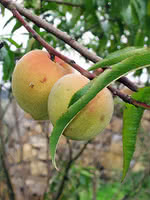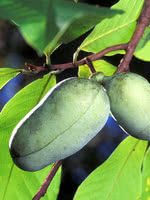Mon-Fri 9am - 5pm Mountain time
Pawpaw vs Siberian C Peach
Prunus persica Siberian C
Asimina triloba
NOT AVAILABLE THIS SEASON - MIGHT RETURN
The Siberian C Peach is a cold hardy peach cultivar, and the fruit is great for producing juice and fresh eating. This variety is native to the Gobi desert area of China, and is relatively true to seed. In colder climates they might not grow fruit reliably as they require a relatively hot summer for the fruit to produce.
Unlike most peach trees the Siberian C Peach doesn’t require thinning and is quite productive. The fruit are firm enough to handle mechanical harvesting.
While it is possible to graft other peach varieties to the Siberian C Peach, research has shown that the Chui Lum Tao Peach and Tzim Pee Tao Peach are better candidates for rootstock.
The Pawpaw tree produces delicious, sweet fruit with a unique banana-mango flavor. These oblong fruits start yellowish-green and mature to a dark brown in the fall. It is best to leave them on the tree until ripe, as they do not ripen well once picked. Pawpaws can be enjoyed fresh, in baking, or in ice cream.
Pawpaws produce the largest native fruit in North America. They typically grow as a small understory tree or large shrub on wooded slopes, in ravines, and along stream banks. They often spread through root suckers, forming dense thickets over time.
For fruit production to occur more than one genetically different Pawpaw tree is required. Our Pawpaw seedlings are grown from seed so they are all genetically different.
Note: Avoid eating the seeds and skin of the Pawpaw fruit as they can cause stomach pain for some individuals. Contact with the skin of the fruit can also result in skin irritation, so it is recommended to wear gloves during harvest. Plant this tree once. Due to its large tap root transplanting is not recommended.

